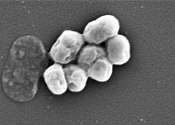Generative AI develops potential new drugs for antibiotic-resistant bacteria
With nearly 5 million deaths linked to antibiotic resistance globally every year, new ways to combat resistant bacterial strains are urgently needed.
Mar 28, 2024
0
95
Hi Tech & Innovation

With nearly 5 million deaths linked to antibiotic resistance globally every year, new ways to combat resistant bacterial strains are urgently needed.
Mar 28, 2024
0
95
Engineering

Combinatorial optimization problems (COPs) have applications in many different fields such as logistics, supply chain management, machine learning, material design and drug discovery, among others, for finding the optimal ...
Mar 25, 2024
0
33
Computer Sciences

In our current age of artificial intelligence, computers can generate their own "art" by way of diffusion models, iteratively adding structure to a noisy initial state until a clear image or video emerges.
Mar 21, 2024
0
44
Electronics & Semiconductors

We are tasking our computers with processing ever-increasing amounts of data to speed up drug discovery, improve weather and climate predictions, train artificial intelligence, and much more. To keep up with this demand, ...
Jan 22, 2024
0
25
Computer Sciences

A new, potentially revolutionary artificial intelligence framework called "Blackout Diffusion" generates images from a completely empty picture, meaning that, unlike other generative diffusion models, the machine-learning ...
Jan 11, 2024
0
89
Computer Sciences

Which drug molecule is most effective? Researchers are feverishly searching for efficient active substances to combat diseases. These compounds often dock onto proteins, which usually are enzymes or receptors that trigger ...
Nov 13, 2023
0
53
Electronics & Semiconductors

A group of 10 universities led by the University of California, San Diego is undertaking a $50.5 million effort to greatly improve the speed and efficiency of computers, work that could do everything from make drug discovery ...
Jan 18, 2023
0
9
Engineering

Machine learning (ML) has been used with impressive success in numerous fields—facial recognition, speech recognition, consumer behavior, and drug discovery. One area where it's had only limited success, though, is as a ...
Jan 18, 2023
0
10
Business

Employers have decided to eliminate hundreds of biotech and tech jobs in the East Bay with layoffs at companies in Emeryville and Newark, a fresh round of unsettling job cuts during uncertain economic times.
Oct 26, 2022
0
2
Computer Sciences

The entirety of the known universe is teeming with an infinite number of molecules. But what fraction of these molecules have potential drug-like traits that can be used to develop life-saving drug treatments? Millions? Billions? ...
Jul 12, 2022
1
496
In the fields of medicine, biotechnology and pharmacology, drug discovery is the process by which drugs are discovered and/or designed.
In the past most drugs have been discovered either by identifying the active ingredient from traditional remedies or by serendipitous discovery. A new approach has been to understand how disease and infection are controlled at the molecular and physiological level and to target specific entities based on this knowledge.
The process of drug discovery involves the identification of candidates, synthesis, characterization, screening, and assays for therapeutic efficacy. Once a compound has shown its value in these tests, it will begin the process of drug development prior to clinical trials.
Despite advances in technology and understanding of biological systems, drug discovery is still a lengthy, "expensive, difficult, and inefficient process" with low rate of new therapeutic discovery. Information on the human genome, its sequence and what it encodes has been hailed as a potential windfall for drug discovery, promising to virtually eliminate the bottleneck in therapeutic targets that has been one limiting factor on the rate of therapeutic discovery.[citation needed] However, data indicates that "new targets" as opposed to "established targets" are more prone to drug discovery project failure in general[citation needed] This data corroborates some thinking underlying a pharmaceutical industry trend beginning at the turn of the twenty-first century and continuing today which finds more risk aversion in target selection among multi-national pharmaceutical companies.[citation needed]
This text uses material from Wikipedia, licensed under CC BY-SA